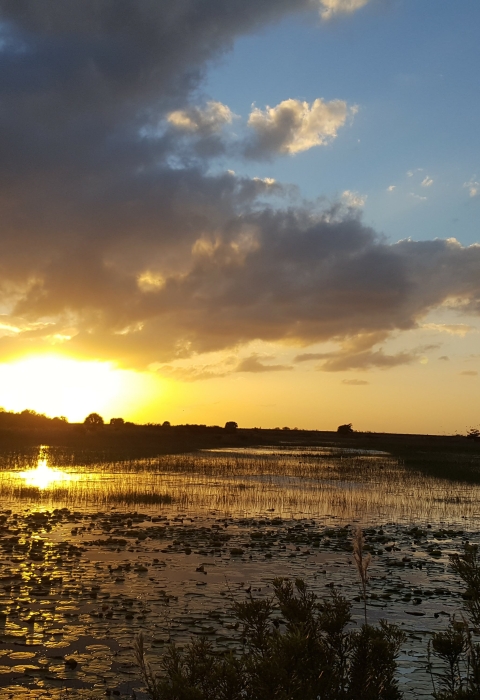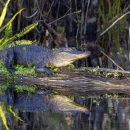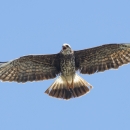Seasons of Wildlife
More than 250 species of birds, 60 species of reptiles and amphibians, 40 species of butterflies, and 20 types of mammals are found on the refuge. Visitors frequently see alligators, bobcats, white-tailed deer, along with a variety of bird-life including sandhill cranes, pileated woodpeckers, herons, egrets, wood storks and the federally endangered snail kite.
Check out recent birds sightings on eBird and wildlife sightings on iNaturalist.
Here's what you can see throughout the year:
January
Many bird groups spend the winter season at the refuge. Hawks and owls can be seen foraging over the wetlands or in the trees, including resident and migratory red-shouldered hawks. Hundreds of American robins, cedar-waxwings, and tree swallows are sometimes foraging in trees. Winter warblers such as prairie, orange-crowned, yellow-rumped warblers, northern water thrush, and ovenbirds also are found.
February
Wintering shorebirds can be seen in addition to the wintering raptors, waders, and passerines. Wintering secretive marsh birds can sometimes be heard. Florida and migrant red-shouldered hawks continue to be abundant this month. Bald eagles should be sitting on eggs, and snail kites are engaged in courtship behavior.
March
Some northern waterfowl species remain. Thousands of tree swallows begin gathering for their northern migration in late spring. Usually, water levels are slowly dropping in the interior portions of the refuge and most of the smaller wading birds and great egrets are starting courtship behaviors and are in full breeding plumage. The first black-neck stilts start to arrive for their nesting season. Most of the shorebirds wintering on the refuge have migrated to the northern parts of their ranges, and spring shorebird migrants will be arriving in April. Kingfishers and common snipe begin to migrate north this month.
April
Alligators may be heard bellowing. Snail kite nests should have chicks near fledging age. As the water levels continue to lower during this dry down season, wading birds such as little blue herons, tri-colored herons, snowy and great egrets, and glossy and white ibis should be into full phase nesting; sitting on eggs or having chicks. A few American bitterns still remain, but most have migrated north. Least bitterns are in full breeding color. Late month reveals an increase in migrating shorebirds on exposed mud flats. Resident red-shouldered hawks are courting and beginning nesting activities.
May
Black-necked stilts are nesting on mud flats. American bitterns and belted kingfishers have probably migrated north by now. Alligators continue to bellow this month. If water levels are quite low, alligators may be concentrated in the canals or in small pools of open water (alligator holes) in the interior of the refuge. Numerous turtle nests (soft-shelled, red-bellied, snapping, and peninsula cooters) are being dug. Migrant shorebirds move northward. Some species that could be observed include lesser and greater yellowlegs, and solitary, stilt, spotted, least, semi-palmated, pectoral, and white-rumped sandpipers. White-tailed deer buck’s antlers are covered in velvet.
June
Continued hot and dry conditions keep most species out of the sun during the day. During this time of year, wildlife hunkers down for survival, and few animals are easily observed. Unless the wet season rains come, the water levels are usually quite low. Extended periods of hot temperature and no rain can contribute to decreased oxygen availability, resulting in the fish kills along the L-40 canal. Alligators are building nests. Daytime raccoon activity seems to increase. By the end of the month, rain usually brings water levels up. Red-shouldered hawks may have chicks in their nests.
July
Rainy season is usually in full swing. Juvenile otters can be occasionally seen along the roads or levees near the water. Some white-tailed deer bucks are still in velvet. Female alligators are attending their nests.
August
Butterflies are becoming more numerous as summer rains encourage grass and other plant blossoming. .Alligator nests hatch at the end of the month and hatchlings may be visible. An early migrant, the blue-gray gnatcatchers can be sometimes heard this month.
September
Early passerine migrants can be seen. Six to nine species of warblers and occasionally Baltimore orioles, scarlet and summer tanagers, and hermit thrushes can be found during this fall migration.
October
Raptors start arriving for the winter, including vultures, American kestrels, Cooper’s and sharp-shinned hawks, and northern harriers. The first merlins and peregrine falcons of the fall season are usually seen this month. Florida red-shouldered hawks are abundant, and fall migrants are arriving. Bobolinks and eastern kingbirds can be heard and seen migrating southward. Generally speaking, teal and pied-billed grebes show up, but ducks do not appear until later in the year. Belted kingfishers arrive and are commonly seen on the impoundments. Secretive marsh birds such as king, sora, black, and Virginia rails can often be heard, but not seen.
November
Hurricanes occasionally approaching from the west side of the state in the fall will enhance the sightings of passerines such as Blackburnian Brewster’s, blue-winged, ceruleans, and chestnut-sided warblers. Pied billed grebes have migrated in for the winter and are easily observed in the impoundments. When they arrive they tend to stay in tight feeding groups, but soon disperse and forage individually. Northern wintering migrants continue to arrive to increase our year-round resident bird numbers. Some of these are palm warblers, grey catbirds, blue grey gnatcatchers, great-crested flycatcher, blue jays, northern cardinals, and white-eyed vireos. Bobcat kittens can be seen with their mother occasionally. River otters are observed regularly. Hundreds of tree swallows can occasionally be seen over the impoundments. Wintering waders are foraging in many locations and can be observed easily.
December
With cooler weather, small mammals are seen more frequently. Early morning visitors may see racoons, otters, and marsh rabbits along the impoundment edges in the tall grasses. The number of wading and marsh birds increase with the cooler and drier weather.
Featured Species
Phenology is the study of periodic plant and animal life cycle events and how these are influenced by seasonal and inter-annual variations in climate, as well as habitat factors (such as elevation). All animals in the refuge are wild, should be respected, and can potentially cause harm. To be safe, do not interact with or feed the wildlife, avoid dangerous situations. Keep your distance. If you approach and they change their behavior, you are too close. The best time to view wildlife is either early morning or at dusk.


